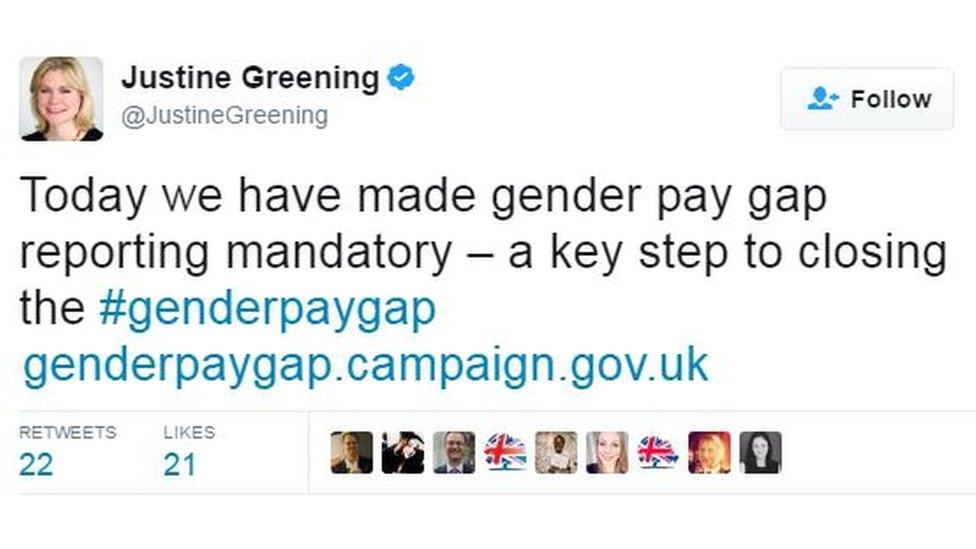Gender pay gaps must be declared by UK companies
- Published
- comments

UK companies with 250 or more employees will have to publish their gender pay gaps within the next year under a new legal requirement.
The move is part of attempts to fight workplace discrimination.
The UK gender pay gap is 18.1% for all workers, or 9.4% for full-time staff.
Women and Equalities minister Justine Greening said "helping women to reach their full potential isn't only the right thing to do, it makes good economic sense".
Public, private and voluntary sector firms are now all required to disclose average pay for men and women, including any bonuses.
About half of the UK workforce will be affected by the new reporting rules, which encompass 9,000 employers and more than 15 million employees.
Firms must publish a snapshot of their employee pay as at 5 April 2017 if they are a private business or charity, or 31 March 2017 for those in the public sector. All the data will eventually be available on a government database, external.
As of lunchtime on the first day of the new reporting rules, no companies had published information through that database. A few firms including Virgin Money and Deloitte had already published their figures prior to the government's campaign launch.
The gender pay gap refers to the difference in average pay between men and woman, which the Office for National Statistics works out using median hourly earnings figures, external for UK employees.

When will companies show their figures?
April 2018 is the final deadline. Until then, it may take weeks or months for the UK's largest companies to publish the differences between what they pay men and women.
Fund manager Schroders became the first FTSE 100 company to go public, revealing in a remuneration report, external that pay for female staff was 33% lower on average.
Many other publicly-listed firms are expected to reveal pay figures alongside their annual reports, which look back on that company's activity for the previous year.
Crowley Woodford, an employment partner at law firm Ashurst, said to expect "fireworks" of publicity for the first employers which reveal data.
But he added: "Many employers are hoping this will go the way of Norway, where after some initial surprise, it soon became old news."

If employers fail to comply by the April 2018 deadline, they will be contacted by the Equalities and Human Rights Commission.
Companies that discover they do have a gender pay gap will be encouraged to publish an action plan alongside the figures detailing the steps they plan to take to address the problem.

Other countries are also working to eradicate the gender pay gap. Iceland is debating a bill that would require companies with more than 25 employees to prove they do not discriminate between male and female workers.
The country has the smallest gap, according to the World Economic Forum's Gender Pay Gap Index, while the UK is in 20th place.
By April 2018, large and mid-sized companies in the UK must:
Publish their median gender pay gap figures, which compare the pay of the man and woman who are at the mid-point of the company payroll.
Publish their mean gender pay gap figures - produced by dividing the total payroll by the number of workers.
Publish the proportion of men and women in each quarter of the pay structure.
Publish the gender pay gaps for bonuses
Pay gap vs equal pay
The gender pay gap and equal pay are two different things. The former is the difference in average earnings between men and woman. Equal pay, or paying men and woman the same amount to do the same job, has been a legal requirement for more than 40 years.
"Today sees a big step forward in the journey to achieve gender parity in the UK," said Emma Codd from Deloitte UK, which already publishes figures on its gender pay gap.
"For the first time people will be able to see the gender pay gap of large employers at one fixed point in time, with this gap measured and reported in a consistent way."
Gender pay gap: What every woman should know
Should the gender pay gap be illegal?
But Sam Bowman from the Adam Smith Institute, described the new measure as "counterproductive".
"It reinforces the idea that the gender wage gap is caused by discrimination by firms against women," he said.
"In fact, it's more to do with the fact that women are expected to take quite a lot of time out of their jobs after they have children, which interrupts their career progression, and many switch to part-time work when they do return to work.
"We have more of a motherhood pay gap than a gender pay gap. That gap can be closed by encouraging men to handle a more equal share of child-rearing time and by consumers preferring firms that take the lead in giving flexibility to working mothers."
- Published6 April 2017

- Published5 April 2017

- Published21 December 2016

- Published24 September 2016

- Published29 August 2016
